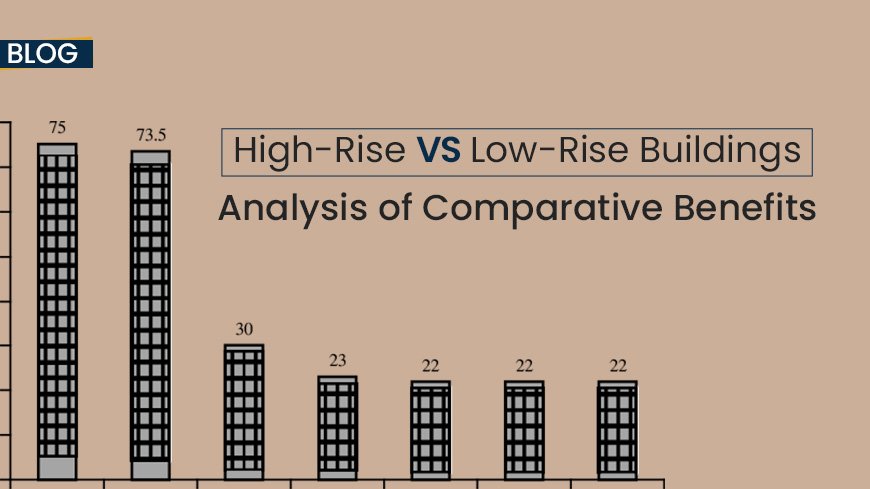- November 8, 2023
- Posted by: Muhammad Afzaal
- Category: Blogs

Introduction
Choosing between high-rise and low-rise is critical when buying or constructing any building, along with some significant implications like functionality and sustainability. When we assume high-rise vs low-rise buildings they both have their advantages and disadvantages. These facts are essential to analyze and compare their benefits to understand which of them is better to invest in.
In this blog post, we’ll explore the comparative benefits of high-rise and low-rise buildings by considering various aspects.
High-Rise VS Low-Rise Buildings
Here are some key aspects of high-rise and low-rise buildings that differentiate them individually by their appearance and functionality.
Density and Land Use Efficiency
One of the primary benefits of high-rise buildings is their ability to maximize the use of limited urban space. High-rises can accommodate a large number of residents or businesses in a relatively small footprint, making them ideal for densely populated cities where land is at a premium.
In contrast, low-rise buildings typically have a lower population density, which can lead to the expansion of urban areas. While this can offer a more spacious and less crowded environment, it often results in increased transportation needs and a larger ecological footprint. Therefore, high-rises are often favored for their ability to support higher population densities in urban centers.
Environmental Impact
High-rise buildings can be more environmentally friendly in some aspects. Additionally, high-rises can take advantage of innovations in green building technologies, such as energy-efficient HVAC systems, solar panels, and water recycling systems, to reduce their carbon footprint.
On the other hand, low-rise typically requires more land, leading to greater resource consumption and emissions from transportation. However, low-rise buildings can integrate sustainable features, such as green roofs, rainwater harvesting, and passive solar design, to mitigate their environmental impact.
Read: Why Should You Choose A Perfect Real Estate And Construction Company?
Visual Appeal and Skyline
It is subjective to determine how high-rise and low-rise buildings visually affect a city’s skyline and general aesthetics. In addition to providing memorable skylines, high-rise structures can evoke a feeling of modernism and urban vibrancy. It can be exciting to see tall skyscrapers contrasted with the sky as a symbol of advancement and creativity.
In contrast, low-rise buildings often offer a more human-scale environment that can be aesthetically pleasing and provide a sense of intimacy. They blend better with historic neighborhoods and contribute to a more traditional or cozy atmosphere.
Quality of Life
Choosing between low-rise and high-rise buildings can make a big difference in how people live. High-rise buildings have cool stuff like gyms, pools, and helpful staff. They’re also close to work and fun things in the city.
Low-rise buildings are quieter and more like a cozy neighborhood. People usually have more grass and outdoor space. It makes them feel good and close to nature. But it might be less convenient because they might not have as many cool things in the building.
Safety and Accessibility
High-rise buildings present unique safety and accessibility challenges. In the event of an emergency, such as a fire or earthquake, evacuating a high-rise can be more complex and time-consuming. High-rises also require reliable vertical transportation systems, such as elevators, to ensure accessibility for all residents, including those with mobility challenges.
Low-rise buildings are generally safer in emergencies and offer easier accessibility. Residents can often exit the building more quickly, and many low-rises have direct outdoor access from individual units.
Cost and Affordability
The cost of construction and living in high-rise versus low-rise buildings can vary significantly. High-rise buildings often require more expensive construction methods, materials, and infrastructure, which can translate to higher purchase or rental prices.
Low-rise buildings are generally more affordable to construct and maintain. Their lower heights mean simpler structural requirements and more cost-effective building materials. Additionally, the cost of land acquisition for low-rise projects is typically lower, making them more accessible to a broader range of income levels.
Benefits of High-Rise Buildings
- High-rise buildings make efficient use of limited urban space, allowing for higher population density.
- They can contribute to a city’s distinctive skyline and architectural character.
- High-rises often offer scenic views of the surrounding area.
- They may be located in city centers, reducing commute times for residents.
- Modern high-rises can be designed with energy-efficient features.
- They often have on-site amenities like gyms, pools, and rooftop gardens.
Benefits of Low-Rise Buildings
- Low-rise buildings are more in harmony with the human scale and can create a cozy, community-oriented atmosphere.
- Easier access to natural light and ventilation due to fewer floors.
- They often contribute to a neighborhood’s character and maintain a sense of community.
- More space for gardens and green areas, promoting outdoor activities.
- Generally more accessible without the need for elevators, making them suitable for people with mobility issues.
- Typically costs less to construct than high-rises.
Also Read: How Should You Inspect An Apartment Before Purchasing It?
Conclusion
In conclusion, the choice between high-rise and low-rise buildings should consider various factors, including density, environmental impact, aesthetics, quality of life, safety, accessibility, and cost. Sometimes, having a mix of both high-rise and low-rise buildings in a city is a good idea. It helps the city grow in a good way and gives people different places to live and work. In the end, we should think carefully about the advantages of each type of building to make a city that makes people happy and grows in a sustainable way.
